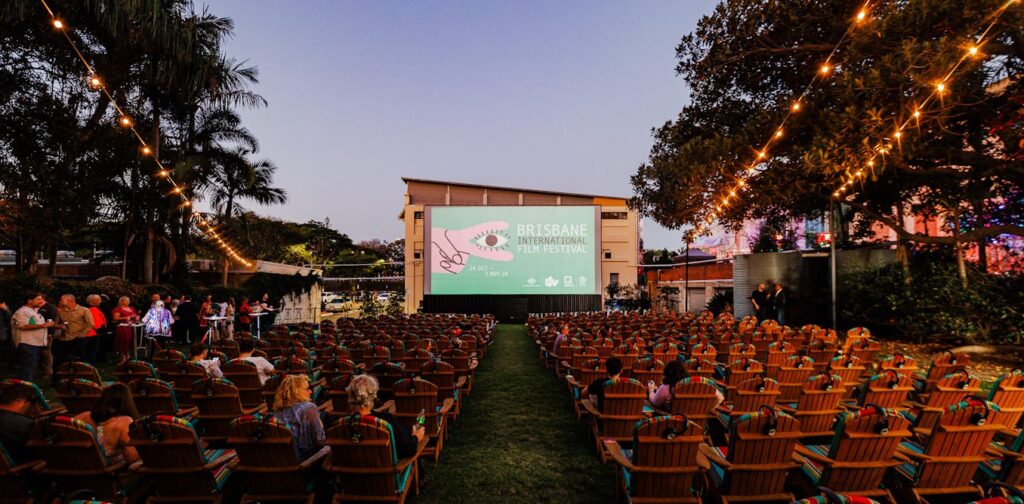In December 1916, as war raged in Europe, an entrepreneurial pearl diver took a chance on some bleeding-edge technology and installed an outdoor cinema in one of the country’s most isolated towns – Broome, Western Australia.
Ted Hunter didn’t know much about cinemas. Not many people did at the turn of the 20th century. But that didn’t stop him beginning what has become a long history of outdoor cinema exhibition in Australia.
Sun Pictures in Broome opened with Jack Hulcup’s 1913 silent film Kissing Cup, in which a “squire’s jockey” escapes kidnappers and gallops across the Isle of Wight in time to win the race. Huzzah.
More than a century later, Sun Pictures still stands – the world’s oldest operating open-air cinema.
Wikimedia, CC BY-SA
While the Guinness World Record is a nice-to-have, Sun Pictures’ survival has been ensured not by the latest Hollywood blockbuster, but by what the cinema offers locals and visitors each night: a moviegoing experience that is at once unique and familiar.
Segregation at the movies
Before opening Sun Pictures, Hunter made his money as a master pearler. Pearl shells, which were turned into mother-of-pearl buttons, transformed the economic life of Broome in the late 1800s. Despite being so isolated, the pearling industry brought great riches to the town, while also entrenching workers along racial lines.
Racial segregation was firmly present in Broome’s “picture garden” for the first half of the 20th century. White Australians and their kids were seated in the middle, with Chinese and Japanese patrons behind them. Malays, Filipinos and First Nations people entered separately and were seated at the sides, or remained standing.
Diana Plater/AP
Aboriginal rights activist Charles Perkins would later directly challenge the segregation of Australian cinemas in his 1965 “Freedom Ride” throughout rural New South Wales.
Outdoors, from the comfort of your car
My colleague Tess Van Hemert and I have spent the past three years researching the cultures and practices of cinemagoing and how cinema sites shape this experience.
Outdoor cinemas – whether they be the picture gardens of Broome or the Yatala Drive-In – function as special sites of culture, connection and community.
During COVID lockdowns, social distancing measures particularly invigorated drive-in cinema attendance. But even after lockdowns ended, David Kilderry, the long-time operator of Melbourne’s Lunar Drive-in, remains clear on the appeal:
You could open up the car or even sit outside it and if cool, hop back inside and snuggle up in private. […] You can talk about the film as it runs. Kids can ask questions and parents can explain. Patrons can use phones during the film without interrupting others, and babies and infants won’t annoy other customers […] The drive-in has always been more than just a movie experience. It’s where the two icons of the 20th century come together: the motion picture and the automobile.
While the Lunar was shuttered in 2023, Kilderry said this decision was less about the 400,000 annual patrons and more about the land tax implications of keeping a site of that size viable.
But it’s not all doom and gloom for drive-ins. Kilderry notes many operators now own their land, rather than trying to constantly negotiate leases.
There are currently about 12 drive-ins running regularly across Australia, with a few more opening for the occasional screening. New drive-in developments are also planned for Perth, pending local consultations.
Connecting with others and the environement
Beyond drive-ins, Sun Pictures is in good company with a range of locations around the world that actively celebrate outdoor cinema.
During the European summer, open-air cinemas are popular in countries such as Germany and Italy. In Bologna, three large piazzas – Piazza Maggiore, Arena Puccini and Piazzetta Pasolini – are set up as cinemas for the annual Cinema Ritrovato festival.
Petros Giannakouris/AP
Closer to home, the University of Western Australia’s Somerville Auditorium, framed by a “tree cathedral” of mature Norfolk pines, has long been a place of unique outdoor cinema experiences.
Perth Festival film programmer Tom Vincent understands the distinct pleasures of outdoor cinemagoing:
The m ost memorable cinemagoing anywhere will always engage the audience’s sense of place, usually through architecture and experience design. […] It includes a natural sensory mix that includes river breezes, ambient sounds and wildlife, alongside a sense of grandeur and good programming. Good outdoor cinema says ‘look, we are here, engage all your senses’.
But while seasonal outdoor cinemas such as the Moonlight Cinemas continue to operate around Australia – alongside local council park screenings – openings of new permanent outdoor cinemas are rare.
Phoebe Condon, manager of the new permanent Dendy Powerhouse Outdoor Cinema in Brisbane, explained how the site positions itself as a high-value leisure experience:
It’s more than just a night at the movies – it’s a destination […] What truly sets us apart from other outdoor cinemas is our focus on creating an elevated, year-round experience.
This framing of outdoor cinema as an “elevated experience” is vital. While the cost of cinemagoing has come up as a key consideration in our research (especially in the current economic context) the industry is quick to remind consumers it remains affordable compared with other out-of-home arts and leisure experiences such as live sports, music, comedy and theatre.
Despite legitimate cost-of-living concerns, census data continues to show cinemagoing as the nation’s most popular cultural activity.
Why Neflix can’t replace cinemas
Our research on Australian cinemagoing supports broader arguments for a more holistic understanding of cinema’s value in society. Cinemagoing shouldn’t be compared to your Netflix subscription, but to other leisure activities people get up and leave the house for.
As the International Union of Cinemas notes, “films reflect national culture or subcultures and the wider world to the audience; they frame moral and political discussions; and they entertain and educate”.
We also know cinemagoing has never stood still. Ever since Hunter took a chance on outdoor cinema in 1916, these spaces have evolved constantly to respond to new challenges and shifting appetites.
But one aspect remains the same: whether sat under the stars, or parked in a lot, Australians continue to see the value in leaving their homes to connect and share in new stories on the big screen.


